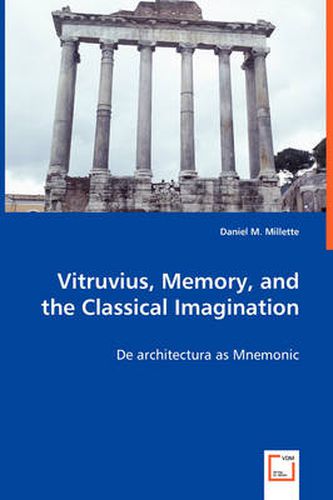Readings Newsletter
Become a Readings Member to make your shopping experience even easier.
Sign in or sign up for free!
You’re not far away from qualifying for FREE standard shipping within Australia
You’ve qualified for FREE standard shipping within Australia
The cart is loading…






This title is printed to order. This book may have been self-published. If so, we cannot guarantee the quality of the content. In the main most books will have gone through the editing process however some may not. We therefore suggest that you be aware of this before ordering this book. If in doubt check either the author or publisher’s details as we are unable to accept any returns unless they are faulty. Please contact us if you have any questions.
Vitruvius lived within spaces that contained implicit architectural codes for him to ponder. He prescribed Roman architecture not as he saw it, but rather, as he imagined it. The Roman architect lived within an urban setting that was highly dynamic and not readily interpreted. Notions related to specific and ideal spaces were stored within the minds of builders and in turn shaped, according to a particular set of pre-existing cultural and built traditions. The corresponding looseness that characterizes the writing of Vitruvius has rendered increasingly imaginative interpretations. Through transcriptions, translations, emendations and the eventual inclusion of drawings, the transformed book has enabled the classical imagination to become fused to memories of what monuments should be. The difficulties arise when the architects and archaeologists of today, eager to convince them-selves and others of their theoretic, forget that the architectural memory residing in the minds of Vitruvius and his architect colleagues remains elusive. Memory was key within the building trades and memory is thus part of our key in interpreting De architectura.
$9.00 standard shipping within Australia
FREE standard shipping within Australia for orders over $100.00
Express & International shipping calculated at checkout
This title is printed to order. This book may have been self-published. If so, we cannot guarantee the quality of the content. In the main most books will have gone through the editing process however some may not. We therefore suggest that you be aware of this before ordering this book. If in doubt check either the author or publisher’s details as we are unable to accept any returns unless they are faulty. Please contact us if you have any questions.
Vitruvius lived within spaces that contained implicit architectural codes for him to ponder. He prescribed Roman architecture not as he saw it, but rather, as he imagined it. The Roman architect lived within an urban setting that was highly dynamic and not readily interpreted. Notions related to specific and ideal spaces were stored within the minds of builders and in turn shaped, according to a particular set of pre-existing cultural and built traditions. The corresponding looseness that characterizes the writing of Vitruvius has rendered increasingly imaginative interpretations. Through transcriptions, translations, emendations and the eventual inclusion of drawings, the transformed book has enabled the classical imagination to become fused to memories of what monuments should be. The difficulties arise when the architects and archaeologists of today, eager to convince them-selves and others of their theoretic, forget that the architectural memory residing in the minds of Vitruvius and his architect colleagues remains elusive. Memory was key within the building trades and memory is thus part of our key in interpreting De architectura.